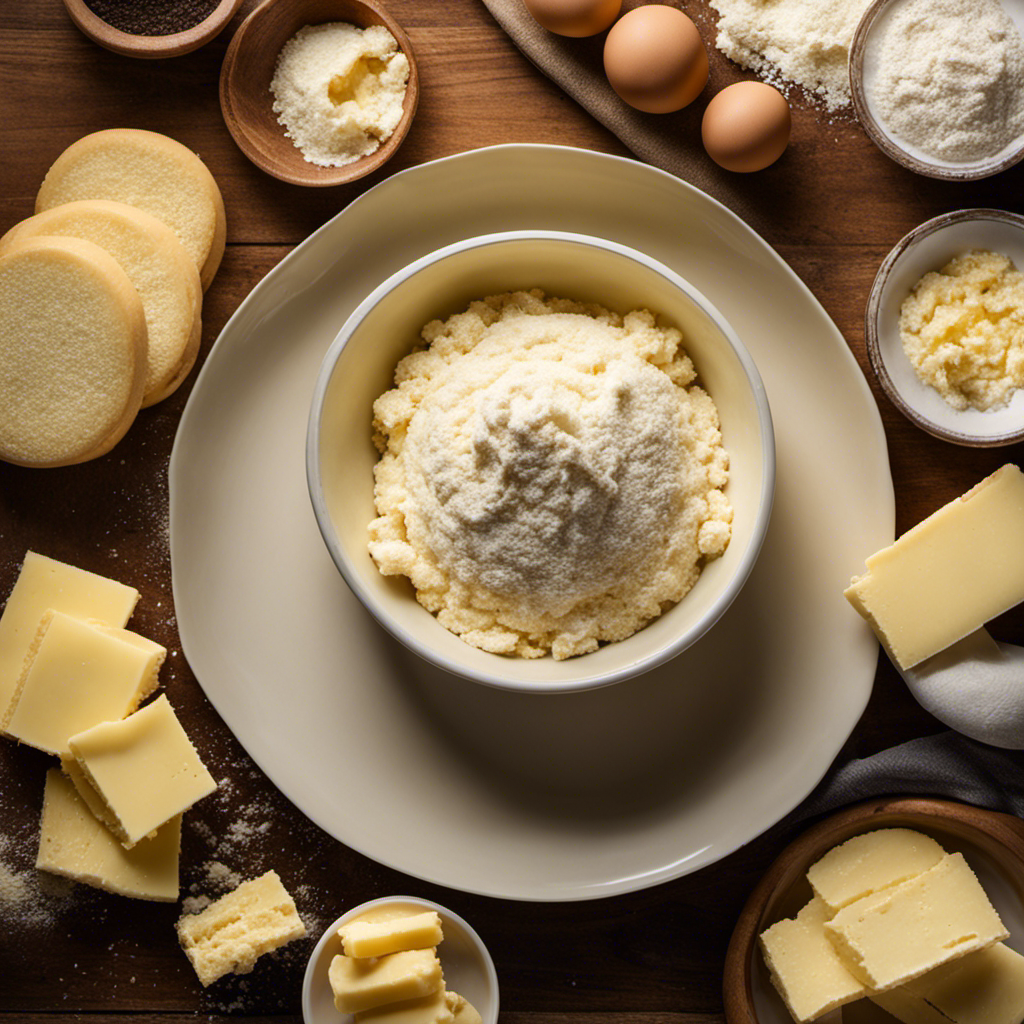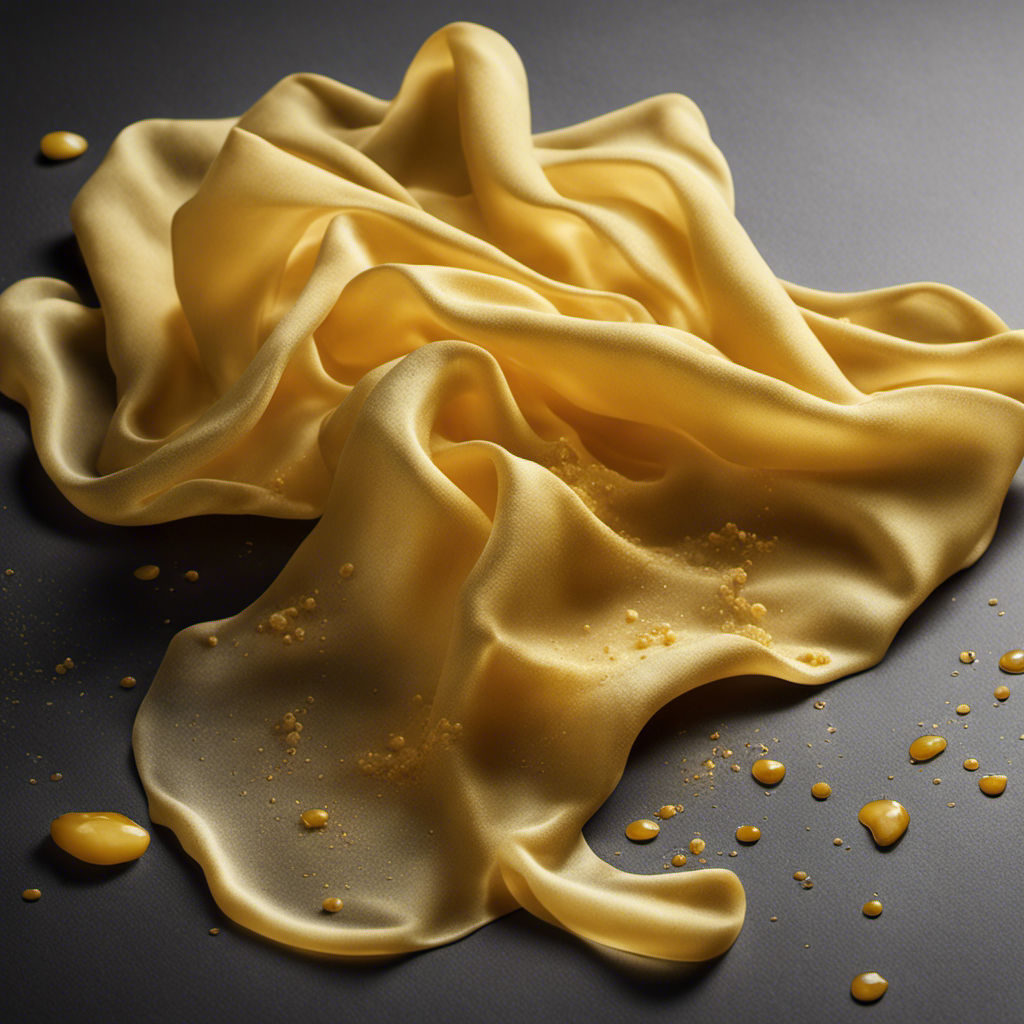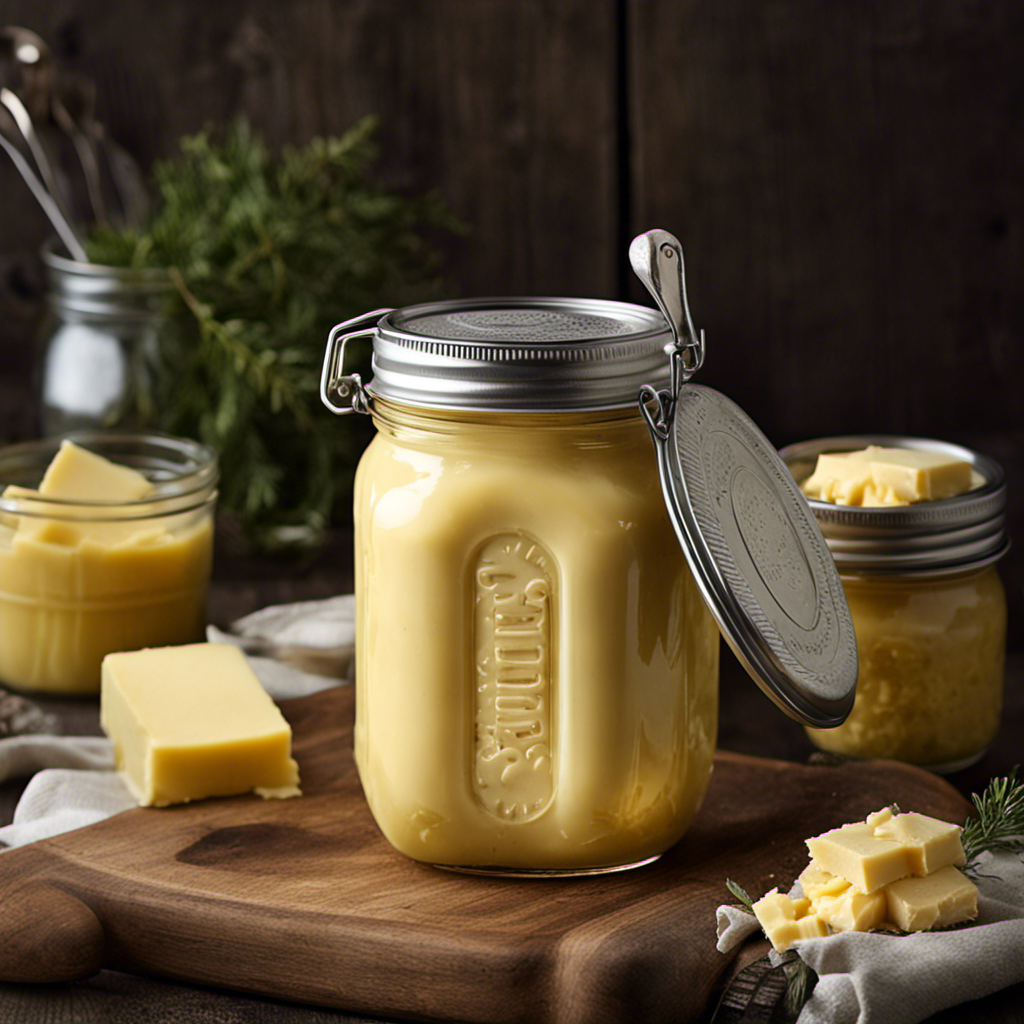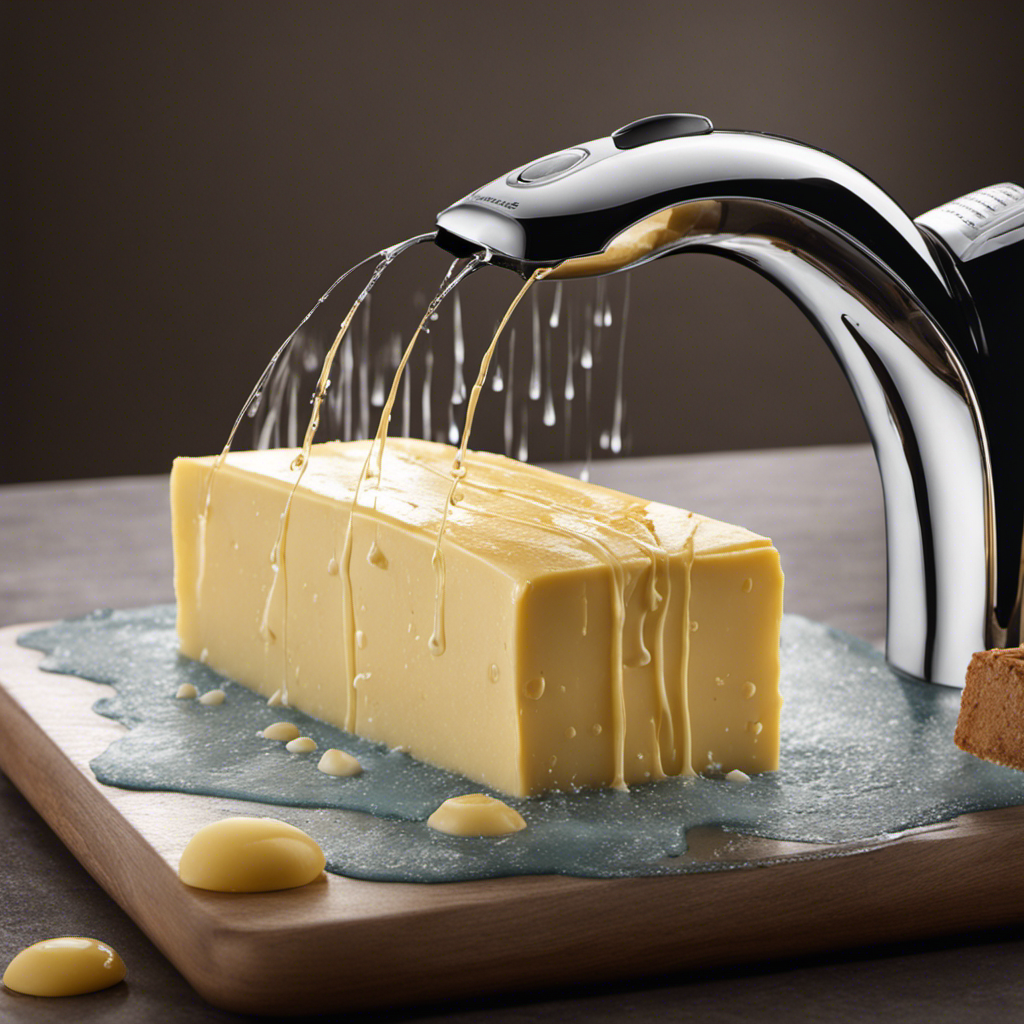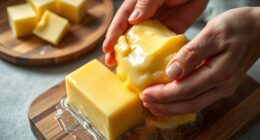I have always believed that blending butter with flour is akin to crafting a culinary work of art. It involves a graceful balance of mixing two basic elements to establish a foundation for a multitude of delectable dishes.
In this article, I’ll guide you through the process of cutting butter into flour, providing you with step-by-step instructions, useful tips, and common mistakes to avoid.
So, grab your apron and let’s embark on this buttery adventure together. Trust me, the end result will be worth it!
Key Takeaways
- Cutting butter into flour creates a flaky texture in baked goods.
- The process involves blending cold butter into flour to form small, pea-sized pieces.
- Cutting butter into flour incorporates butter evenly throughout the flour to create layers in the dough.
- The result is a tender and flaky finished product, perfect for pastries and baked goods.
The Importance of Cutting Butter Into Flour
The importance of cutting butter into flour is that it creates a flaky texture in baked goods. This process involves blending cold butter into flour until it forms small, pea-sized pieces. By incorporating the butter evenly throughout the flour, it creates layers in the dough, which results in a tender and flaky finished product.
To achieve the desired consistency, a few tools are needed. Firstly, a pastry cutter or two knives can be used to cut the butter into the flour. These tools help to break the butter into smaller pieces without melting it. Additionally, a large mixing bowl and a clean, cool workspace are essential for this process.
With the right tools and technique, cutting butter into flour is a crucial step in creating deliciously flaky pastries and baked goods.
Next, let’s discuss the tools and equipment needed for this process.
Tools and Equipment Needed for Cutting Butter Into Flour
To successfully blend butter with flour, you’ll need a pastry cutter or two knives. The tools needed for cutting butter into flour are simple yet essential for achieving the desired texture in your baked goods. Here are the best techniques and tools to use:
-
Pastry Cutter: This tool is specifically designed for cutting butter into flour. It features sharp blades that easily blend the ingredients together, creating a crumbly texture.
-
Two Knives: If you don’t have a pastry cutter, two knives can be used as a substitute. Hold a knife in each hand and cross them over each other while cutting through the butter and flour mixture. Repeat this motion until the desired consistency is achieved.
-
Food Processor: For a quicker and more efficient method, a food processor can be used. Simply pulse the butter and flour mixture until it resembles coarse crumbs.
Step-By-Step Instructions for Cutting Butter Into Flour
Start by ensuring you have the necessary tools and equipment for cutting butter into flour. To achieve the desired consistency, it’s important to use optimal mixing techniques. Here is a step-by-step guide on how to cut butter into flour effectively:
- Start by measuring the required amount of cold butter and flour.
- Cut the cold butter into small cubes and place them back in the refrigerator to keep them chilled.
- In a large mixing bowl, combine the cold butter cubes and flour.
- Using a pastry cutter or two knives, cut the butter into the flour until the mixture resembles coarse crumbs.
Table: Optimal Mixing Techniques
| Tools and Equipment |
|---|
| Pastry cutter |
| Two knives |
| Large mixing bowl |
| Measuring cups |
Tips and Tricks for a Perfect Butter and Flour Mixture
When it comes to achieving the desired consistency in a butter and flour mixture, optimal mixing techniques play a crucial role.
To ensure a perfect blend, it is important to use a pastry blender or two knives to cut the butter into small pieces and incorporate it evenly with the flour.
Optimal Mixing Techniques
For the best results, it’s important to cut the butter into the flour using a pastry blender or your fingertips. Here are some tips for achieving optimal mixing techniques:
-
Optimal Mixing Speed: When cutting butter into flour, it’s crucial to work quickly and efficiently. This helps prevent the butter from melting and ensures a flaky texture in your final product. Aim for a moderate speed, neither too slow nor too fast, to achieve the best results.
-
Different Types of Butter: The type of butter you choose can also affect the mixing process. For example, using cold, unsalted butter is ideal because it helps create a tender and flaky dough. Avoid using melted or room temperature butter, as it can change the consistency of the mixture.
-
Proper Technique: Whether you use a pastry blender or your fingertips, the key is to incorporate the butter into the flour until it resembles coarse crumbs. Be careful not to overmix, as this can lead to a tough dough.
Achieving Desired Consistency
To achieve the desired consistency, aim for a dough that is neither too dry nor too sticky by adding the liquid gradually. This is crucial in ensuring that the dough turns out perfect.
Start by cutting the cold butter into small cubes and adding it to the flour mixture. Using a pastry cutter or your fingertips, work the butter into the flour until it resembles coarse crumbs. This step is important as it helps distribute the butter evenly throughout the dough, resulting in a flaky texture.
Once the butter is incorporated, gradually add the liquid, such as water or milk, while gently mixing until the dough comes together. It’s important to test the doneness of the dough by lightly pressing it with your fingertips. If it holds its shape without crumbling, then you have achieved the desired consistency.
Common Mistakes to Avoid When Cutting Butter Into Flour
When it comes to cutting butter into flour, there are a few key points to keep in mind.
First, the temperature of the butter is crucial. It needs to be cold, but not too cold or too soft.
Second, using the proper cutting technique is essential for achieving the desired texture in your baked goods.
Lastly, over-mixing the butter and flour can lead to tough and dense results, so it’s important to know when to stop mixing.
Butter Temperature Importance
The temperature of the butter is crucial when cutting it into flour. The right temperature can greatly affect the final texture of your baked goods, especially when you’re aiming for a flaky result. Here are three key effects of butter temperature on achieving a flaky texture:
-
Cold butter: Using cold butter, straight from the fridge, is essential for achieving flakiness. The cold butter creates small pockets of fat in the dough, which melt during baking, creating layers and resulting in a light, airy texture.
-
Room temperature butter: If the butter is too soft or at room temperature, it will incorporate more fully into the flour, resulting in a denser, less flaky texture. It’s important to keep the butter cold until you’re ready to cut it into the flour.
-
Over-softened butter: Be cautious not to over-soften the butter, as it can lead to a greasy, heavy texture. The butter should still be cold to the touch, with a slight give when pressed.
Proper Cutting Technique
Make sure your butter is at the right temperature before starting the cutting process. To achieve a flaky pastry, it is crucial to use the optimal cutting technique.
Begin by cutting cold butter into small cubes. This will ensure even distribution throughout the dough.
Using a pastry cutter or your fingertips, gently incorporate the butter into the flour mixture. The goal is to create small, pea-sized pieces of butter coated in flour. Avoid overmixing or melting the butter, as this will result in a dense and tough pastry.
The key is to maintain the cold temperature of the butter, as this will create steam during baking, leading to layers and a light, flaky texture.
With practice and attention to detail, you’ll master the art of cutting butter into flour for perfect pastries every time.
Over-Mixing Risks
After mastering the proper cutting technique, it’s important to be mindful of the risks associated with over-mixing. Over-mixing can lead to consequences that can affect the final texture of your baked goods. Here are some risks to be aware of and tips to prevent them:
-
Tough Texture: Over-mixing can cause the gluten in the flour to develop excessively, resulting in a tough and chewy texture. To avoid this, mix the butter and flour just until they resemble coarse crumbs.
-
Loss of Flakiness: Over-mixing can also lead to a loss of flakiness in pastries and pie crusts. To achieve a flaky texture, it’s important to maintain small pieces of butter in the dough. Be careful not to overwork the mixture.
-
Uneven Distribution: Excessive mixing can cause uneven distribution of ingredients, resulting in an inconsistent final product. To ensure even distribution, stop mixing as soon as the butter and flour are combined and there are no large chunks of butter left.
Alternative Methods for Incorporating Butter Into Flour
To incorporate butter into flour, you can try using a pastry cutter or your hands for a more hands-on approach. These alternative techniques for butter blending can give you different results depending on your preference.
Using a pastry cutter allows you to cut the butter into small, pea-sized pieces, creating a crumbly texture. This method is quick and efficient, ensuring that the butter is evenly distributed throughout the flour.
On the other hand, using your hands gives you greater control over the blending process. By rubbing the butter and flour together, you can create a sandy texture, which is perfect for recipes like pie crusts.
Whichever method you choose, the key is to work quickly to prevent the butter from melting.
Transitioning into the next section, once the butter is incorporated, it’s important to determine the right consistency for the butter and flour mixture.
How to Determine the Right Consistency for the Butter and Flour Mixture
After exploring alternative methods for incorporating butter into flour, it’s crucial to determine the right consistency for the mixture. This step is essential for achieving a flaky texture in your baked goods.
Here are three key factors to consider:
-
Butter and Flour Ratio: The ratio of butter to flour plays a significant role in determining the consistency. For a flaky texture, a higher ratio of butter to flour is preferred. This will create distinct layers in the dough when it bakes.
-
Cold Butter: It is important to use cold butter when cutting it into the flour. Cold butter creates small pockets of fat within the dough, resulting in a flaky texture.
-
Pea-sized Butter Pieces: When cutting the butter into the flour, aim for pea-sized pieces. These small chunks of butter will melt during baking and create steam, which lifts the layers of the dough, resulting in a flaky texture.
Troubleshooting Common Issues When Cutting Butter Into Flour
When troubleshooting common issues, it’s important to remember that the temperature of the butter can greatly impact the process of incorporating it into the flour. Achieving the desired consistency when cutting butter into flour can be tricky, but with some troubleshooting, it can be easily resolved. Here are some common issues and their solutions:
| Issue | Solution |
|---|---|
| Butter is too soft | Chill the butter in the fridge for 15-30 minutes before cutting it into the flour. |
| Butter is too hard | Grate the butter using a box grater or cut it into small cubes and let it sit at room temperature for a few minutes before cutting it into the flour. |
| Butter is not evenly distributed | Use a pastry cutter or two knives to cut the butter into the flour until it resembles coarse crumbs. |
| Dough is too dry | Sprinkle a little cold water (1 tablespoon at a time) over the mixture and gently toss with a fork until the dough comes together. |
Frequently Asked Questions
Can I Use a Food Processor Instead of a Pastry Cutter to Cut Butter Into Flour?
Yes, you can use a food processor instead of a pastry cutter to cut butter into flour. It’s a quicker method and can result in a more even distribution. However, be careful not to over-process the mixture.
How Long Can I Store the Butter and Flour Mixture Before Using It in a Recipe?
I can store the butter and flour mixture before using it in a recipe, but it may affect the outcome. Storing can cause the butter to melt or become too soft, resulting in a different texture or consistency in the final dish.
Can I Use Margarine Instead of Butter When Cutting It Into Flour?
Using margarine instead of butter when cutting it into flour can affect the texture and flavor of the final product. Alternative techniques for cutting butter into flour include using a fork or your hands.
Is It Necessary to Chill the Butter Before Cutting It Into Flour?
It’s better to use cold butter when cutting it into flour. Chilling the butter helps create a flaky texture in baked goods. Some alternative methods for cutting butter into flour include using a pastry cutter or two knives.
Can I Use a Stand Mixer Instead of a Hand Mixer When Cutting Butter Into Flour?
Sure, you can use a stand mixer instead of a hand mixer for cutting butter into flour. It’s an alternative method that can save time and effort. Just be sure to use the appropriate attachment and mix on low speed to avoid overmixing.
Conclusion
After following the step-by-step instructions and using the right tools and equipment, cutting butter into flour becomes a breeze.
The importance of this technique cannot be overstated, as it creates the perfect texture for various baked goods.
Just like a symphony conductor skillfully guides each musician to create a harmonious melody, cutting butter into flour is like orchestrating a perfect blend of flavors and textures.
So next time you’re in the kitchen, remember to cut the butter into the flour with precision and finesse, and watch your baked creations come to life.
